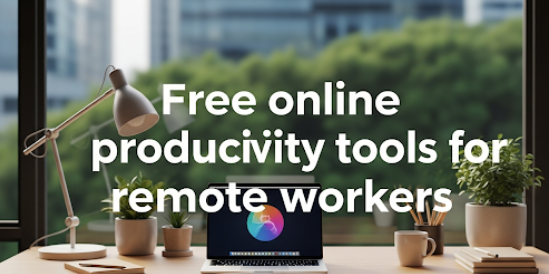The Ultimate Guide to Free Online Productivity Tools for Remote Workers
Thanks to video conferencing leading professional juggler and FLVS peer Brittany Taylor, I decided to put together a list of my favorite free online productivity tools for remote workers. Keep reading so you can also work smarter from home!
Working from home is now the new norm for millions of people across the globe. If you are a freelancer like me, an entrepreneur or part of a remote team, working on your own time can be hard. The good news? You do not have to get costly software simply to assist you with productivity. In this complete guide, we take a closer look at the top free online productivity tools that help you completely reinvent your remote working experience.
Why Remote Workers Need Special Productivity Tools
Remote work introduces certain problems that other office workers never have to deal with. Working from home can leave you feeling unproductive, make it hard to know when to take breaks, or have difficulty with communicating. Luckily, there are a host of free productivity tools to fill up these cracks — before they get too out of hand:
- Structure in an unstructured world
- Improving communication with team members
- Becoming a better time/task tracker
- Reducing digital clutter and overwhelm
- Automating repetitive tasks
It is about finding the right formula of tools that provide you with what you really need for your work.
Organization Tools to Get on Top of That To-Do List
Trello: Project Management Just For You
Drawing inspiration from Japanese Kanban boards, Trello really shook up how project management continues to be done with their card-based system. A free project visualization tool that allows remote workers to structure tasks, deadlines and projects.
Key Features:
- Drag-and-drop task cards
- Customizable boards for different projects
- Team collaboration features
- Due date reminders
- Mobile app synchronization
Best For: Those who are more visually inclined, small teams and those who get a kick out of seeing an overview of their stages.
Todoist: Smart Task Management
This app is the definition of simplicity with powerful features for remote workers to manage your schedule. With its natural language processing, you can easily input tasks by typing stuff like “meeting with client tomorrow at 2 pm”
Key Features:
- Natural language task entry
- Project templates
- Productivity tracking
- Cross-platform synchronization
- Collaboration tools
Ideal for: Detail-conscious task managers seeking an uncluttered experience.
Asana: Team Collaboration Hub
Asana also features paid plans; however, its free version has pretty good functionality for up to 15 team members. Good for remote workers who need to collaborate with team members or manage client projects.
Key Features:
- Various project views: list, board, timeline
- Task dependencies
- Team inbox for updates
- Custom fields
- Basic reporting
Suitable For: Virtual teams, project managers, and people trying to manage multiple projects for separate clients.
Remote Collaboration Platform for Excellent Communication Experience
Slack: Digital Office Water Cooler
Slack dominates remote work communication. The free plan has basic features for distributed team communication and updates from your work.
Key Features:
- Organized channels for different topics
- Direct messaging
- File sharing
- Integration with other productivity tools
- Voice and video calls (limited)
Best For: Teams looking for an organized log of searchable communication.
Discord: Beyond Gaming Communication
Discord was initially created as a chat service for gamers and remote workers have turned it into a communication powerhouse. Its free and open-source features usually beat the paid alternatives.
Key Features:
- High-quality voice and video calls
- Screen sharing
- Unlimited text messaging
- Custom servers with multiple channels
- Bot integrations
Ideal for: Creative teams, more laid-back work environments, and teams that prefer voice calls over writing.
Microsoft Teams: Enterprise-Grade Communication
Microsoft Teams has a very competitive free plan, which encompasses a suite of features you usually have to pay separately for in business software.
Key Features:
- Video meeting up to 100 participants
- File collaboration
- Integration with Office Online
- Chat and channel-based communication
- Screen sharing and recording
Ideal for: Corporate settings, Microsoft users, formal business correspondence.
Time Management and Focus Tools
RescueTime: Automatic Productivity Tracking
RescueTime is a tool that runs in the background of your devices and tracks everything you do! This is particularly wonderful for remote workers as they try to get to the bottom of their productivity cycles and rid themselves of time-wasters.
Key Features:
- Automatic time tracking
- Detailed productivity reports
- Website and application categorization
- Distraction blocking (premium feature)
- Goal setting and alerts
Who It’s Best For: Data nerds who want unbiased feedback on their workflow habits.
Forest: Gamified Focus Sessions
Through virtual tree planting, Forest gamifies productivity with intervals of focused work sessions. Due to this innovative methodology of providing work, employees working from home can focus more and at the same time, create sufficient daily routines.
Key Features:
- Pomodoro technique implementation
- Virtual forest creation
- Social challenges with friends
- Real tree planting partnerships
- Statistics and achievements
Ideal For: People that get distracted by phones and love gamification.
Toggl Track: Simple Time Tracking
Remote workers can easily figure out where their time is going and charge clients correctly using Toggl Track’s intuitive time tracking.
Key Features:
- One-click time tracking
- Project and client organization
- Basic reporting
- Team time tracking
- Browser and mobile apps
Ideal For: Freelancers, consultants and people who have to track billable hours.
File Storage and Document Management
Google Drive: Cloud Storage Champion
Google Drive offers 15GB of free storage, and its excellent productivity suite works with apps in Google’s ecosystem. For remote workers that need to depend on fast and responsive access to their files from anywhere.
Key Features:
- 15GB free storage
- Real-time document collaboration
- Automatic syncing across devices
- Advanced sharing controls
- Integration with Google Workspace
Perfect For: Document collaboration by teams, cloud storage for those that need it.
Dropbox: File Synchronization Expert
One of the original cloud file synchronization products, Dropbox continues to be a solid choice for users working remotely. For FREE, you get 2GB of storage with excellent sync capabilities.
Key Features:
- Automatic file synchronization
- File recovery and version history
- Easy sharing with non-users
- Mobile scanning
- Integration with productivity apps
Best For: Users who value reliability in their file syncing more than storage space.
OneDrive: Microsoft’s Cloud Solution
OneDrive is simple to use with 5GB of free storage and deep Office applications integration making it an excellent candidate for all business remote-work scenarios.
Key Features:
- 5GB free storage
- Office Online integration
- Automatic photo backup
- Version history
- Collaboration features
Best For: Professional environments, Microsoft Office users, Windows device owners.
Note-Taking and Knowledge Management
Notion: All-in-One Workspace
Among other things, Notion does notes + databases + task management all in one tool. This flexibility is what has made it a favorite among remote workers looking to consolidate their digital workspace.
Key Features:
- Block-based content creation
- Database functionality
- Template gallery
- Team collaboration
- API integrations
Best For: Power users, teams that need a centralized knowledge base.
Obsidian: Connected Note-Taking
Obsidian was like having a second brain: the note-taking app connects your notes for you, giving remote workers superpowers in building up a knowledge network that is actually comprehensive.
Key Features:
- Linked note system
- Graph view of connections
- Markdown support
- Plugin ecosystem
- Local file storage
Ideal for: Researchers, writers and anyone who needs to work with complex information.
Evernote: Digital Filing Cabinet
With robust note-taking and powerful search, Evernote’s free plan allows you to capture and retrieve information quickly even for remote workers.
Key Features:
- Web clipper browser extension
- OCR for image text recognition
- Cross-platform synchronization
- Categorize with notebooks and tags
- Basic collaboration features
Ideal For: Data gatherers, students, and people who need robust search functionality.
Video Conferencing and Meeting Tools
Zoom: The Meeting Standard
Most people can get by perfectly fine with Zoom’s free plan, which allows you to make 40-minute sessions in a group and unlimited one-on-one calls.
Key Features:
- HD video and audio quality
- Screen sharing
- Recording capabilities
- Virtual backgrounds
- Waiting rooms for security
Good For: Business meetings, client calls, team check-ins.
Google Meet: Simple Video Conferencing
Google Meet is an easy-to-use video conferencing tool that requires no installation; thereby, it is appropriate for professional-client communication.
Key Features:
- Browser-based meetings
- Integration with Google Calendar
- Real-time captions
- Screen sharing
- Mobile app availability
Ideal for: Stand-ups with your team, clients that need browser-based solutions and users of Google Workspace.

Automation Tools for Workflow Optimization
Zapier: Connect Your Apps
Zapier Free offers basic automation between productivity tools, useful for remote workers who want to remove repetitive tasks and streamline their workflows.
Key Features:
- 5 single-step automations (Zaps)
- 100 tasks per month
- Integration with 2,000+ apps
- Pre-built automation templates
- Simple setup process
Top use cases: Multiple-app remote workers looking to cut down on data entry redundancy.
IFTTT: Simple Automation
For remote workers who require basic automation for both work and personal productivity, IFTTT (If This Then That) is very useful to streamline a number of routine tasks.
Key Features:
- Unlimited applets
- Simple trigger-action format
- Mobile location-based automations
- Social media integrations
- Smart home connectivity
Ideal for: Basic automations, workflows built with a mobile-first mentality and personal productivity workflows.
Top Free Productivity Tools Comparison
| Tool | Category | Best Feature | User Limit | Storage/Usage Limit |
|---|---|---|---|---|
| Trello | Task Management | Visual boards | Up to 10 team members | Unlimited boards |
| Slack | Communication | Channel organization | Up to 10k messages | 5GB File storage |
| Google Drive | File Storage | Real-time collaboration | Unlimited users | 15GB free |
| Zoom | Video Conferencing | HD quality | Up to 100 participants | 40-minute group meetings |
| Notion | All-in-one | Customization | Unlimited personal | 1000 blocks |
| RescueTime | Time Tracking | Automatic tracking | Single user | Only last three months |
What Your Remote Work Productivity Stack Should Look Like
The tool itself is less important though; the real piece is making them all work together. Here’s a recommended approach:
The Minimalist Stack
- Task Management: Todoist
- Communication: Slack
- File Storage: Google Drive
- Video Calls: Google Meet
- Notes: Google Docs
The Power User Stack
- All-in-One: Notion
- Communication: Discord
- File Storage: Dropbox + OneDrive
- Video Calls: Zoom
- Time Tracking: RescueTime
- Automation: Zapier
The Team Collaboration Stack
- Project Management: Asana
- Communication: Microsoft Teams
- File Storage: OneDrive
- Video Calls: Zoom
- Documentation: Notion
- Time Tracking: Toggl
How to Get the Most Out of Your Productivity Tools
Start Small and Scale Up
Don’t try to implement every tool at the same time. Pick one or two tools to focus on and keep the others out of your day-to-day flow. This will also keep you from being overwhelmed and let you use the tools effectively.
Integrate Your Tools
Find solutions that integrate well. Integrations with productivity tools help you build automation into your workflow, allowing you to stop jumping from app to app too much.
Regular Tool Audits
Consider looking through the tools you use every few months and clearing out any that don’t actually enhance your workflow. Uninstall apps which are not necessarily providing benefits to your productivity.
Customize for Your Work Style
Do not miss out on the opportunity to transform the tools you use into doing work the way that suits you best. Many productivity tools make it easy for you to change features in a way that will get you a much better ROI.
Learn Keyboard Shortcuts
Spend some time learning the keyboard shortcuts for your favorite tools. That small investment is going to save you hours of time a year.
Productivity Tool Mistakes to Steer Clear Of
Tool Hopping
Hopping from one productivity tool to another without even giving it a fair shot. Give a tool more time, minimum one month before you decide to continue with it.
Over-Complicating Systems
Building too complex solutions creates more work keeping them up than the productivity they are intended to bring. Make your systems as simple as possible while serving the purpose.
Ignoring Mobile Versions
Failure to leverage the mobile versions of all your productivity apps. Remote work tends to be on-the-go, so make sure that your tools function smoothly on your phone and tablet as well.
Forgetting About Security
Using productivity tools mindlessly without considering security (especially when working with sensitive client information).
Remote Work Productivity Tools of The Future
The world of productivity tools is changing fast. Fueled by artificial intelligence integration, which allows the tools to be more powerful and accessible than ever, on top of improved mobile experiences, combined with even better cross-platform compatibility.
Remote workers will soon find more AI-based functions informing them on automatically organized information, optimal schedules for focused work, and likely bottlenecks in projects. New tools are constantly being released, and it is important to keep up with trends without getting distracted.
Conclusion: The Key to Remote Work Success
With the right mix of free productivity tools, you can turn remote work chaos into control, from disorganization to order. Above are the best free tools from among those tested, each uniquely developed to tackle some of the most common productivity pitfalls of today.
Keep in mind that most expensive is not always the best for you. Some of these free options even compare well with their premium alternatives and are ideal for remote workers on any budget.
Determine your top productivity issues first and then find the tools to specifically solve them. Begin to create your own system, but work it one tool at a time then add on. The key with remote work is if you have the right resources and mindset, you can design a space that not only works for you but gives productivity as well as satisfaction in the long run.
Remote work is clearly the future of work, and by using these productivity tools for free, you are prepared to win in this new environment. Your most productive remote work life is ready to download!




